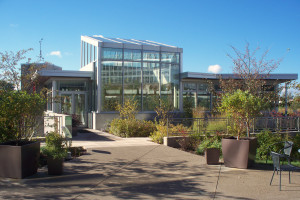

News
Recap: Biophilic Design at Living Future 2016 unConference
Allison Bernett
Share
Learn more about our biophilic design work and services by emailing us at [email protected] and reading our reports, 14 Patterns of Biophilic Design and The Economics of Biophilia. Follow the conversation on twitter: @TerrapinBG | #14Patterns.
This year, biophilic design was a major theme at the International Living Future Institute‘s Living Future 2016 unConference in Seattle, WA. Biophilic design is a crucial component of the Living Building Certification requirements for Health & Happiness, yet many designers still struggle to understand how to implement this emerging practice.
On May 11th, the Living Future unConference hosted the first ever Biophilic Design Summit to help take the practice from theory to reality. Led by ILFI’s Biophilic Design Initiative Advisory Task Force (whose members include Bill Browning and Catie Ryan from Terrapin), the sold-out, five-hour long Summit focused on how to forward this initiative to improve access to biophilic design resources and achieve broad adoption of biophilic design among the design community, building owners and cities.
There was a great deal of feedback from the three work sessions and the Advisory Task Force hopes to distill and disseminate key takeaways and actions over the next few weeks. Discussions revolved around (1) establishing a common, transdisciplinary language for biophilic design, (2) developing and consolidating resources and tools for optimized access, and (3) compiling and sharing educational resources and curricula for early education through to graduate level. Catie Ryan, who helped lead and facilitate the Summit, felt that the popularity and success of this event highlights the excitement around biophilic design:
It’s clear that this initiative is something proponents of biophilic design have been hungry for, and it holds a great deal of potential. A commitment from the biophilic design community will be needed to keep up the momentum and see this through. I’m looking forward to being a part of that.”

The Living Building Certified Center for Sustainable Landscapes at the Phipps Conservatory boasts several instances of biophilic design, particularly auditory connection with nature. Image copyright Dr. Boli/Flickr.
The conference also featured a newly formulated “Biomimicry and Biophilic Design” track. Within this track, Catie Ryan presented on May 12th in the packed session “Biophilic Design: Achieving Broad Adoption.” She was joined by Richard Piacentini, Executive Director of the Phipps Conservatory and Botanical Gardens, and Amanda Sturgeon, CEO of the International Living Future Institute.
Amanda Sturgeon began the session by recapping the Biophilic Design Summit from the previous day and giving an overview of goals and methods for achieving broad adoption of biophilic design. Richard Piacentini spoke about using biophilic design from an owner’s perspective and presented post-occupancy survey results from the Phipps’ new Center for Sustainable Landscapes building (which achieved Living Building Certification). The results showed the direct impacts of biophilic design on employee satisfaction, perception of nature and proactive health behaviors. Mr. Piacentini also elaborated on plans to incorporate biophilic design into their next building project. Catie Ryan shared three case studies on biophilic workplaces and hotels, and introduced a study in collaboration with Interface investigating correlations between biophilic hotel amenities and hotel revenue.
*Seattle skyline header and feature image copyright Howard Ignatius/Flickr.
Allison Bernett
Allison Bernett is an associate project manager and the public relations coordinator for Terrapin Bright Green. She graduated summa cum laude from Washington University in St. Louis with a double major in architecture and biology. Allison’s interests focus on architecture, sustainability, and bioinspired innovation.
Topics
- Environmental Values
- Speaking
- LEED
- Terrapin Team
- Phoebe
- Community Development
- Greenbuild
- Technology
- Biophilic Design Interactive
- Catie Ryan
- Spanish
- Hebrew
- French
- Portuguese
- Publications
- Occupant Comfort
- Materials Science
- Conference
- Psychoacoustics
- Education
- Workshop
- Mass Timber
- Transit
- Carbon Strategy
- connection with natural materials
- interior design
- inspirational hero
- biophilia
- economics of biophilia
- Sustainability
- wood
- case studies
- Systems Integration
- Biophilic Design
- Commercial
- Net Zero
- Resorts & Hospitality
- Energy Utilization
- Water Management
- Corporations and Institutions
- Institutional
- Ecosystem Science
- Green Guidelines
- Profitability
- Climate Resiliency
- Health & Wellbeing
- Indoor Environmental Quality
- Building Performance
- Bioinspired Innovation
- Biodiversity
- Residential
- Master Planning
- Architects and Designers
- Developers and Building Owners
- Governments and NGOs
- Urban Design
- Product Development
- Original Research
- Manufacturing
- Industrial Ecology
- Resource Management
- Sustainability Plans
- Health Care
- Carbon Neutrality


